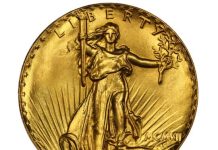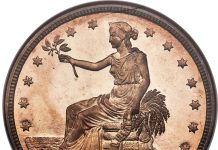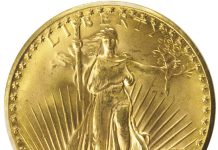 DOLLAR COINS AND COMMON SENSE
DOLLAR COINS AND COMMON SENSE
by Ed Reiter
Looking for logic in Washington, D.C., is like looking for a needle in a haystack. More aptly, it’s like looking for a dollar— a metal one, that is—in pocket change.
The Obama Administration recently pulled the plug on the base-metal presidential dollars, announcing that they will no longer be produced for circulation. The stated reason: to save big money for the government—and, by extension, the American people.
At first blush, this sounds reasonable. Virtually no one has used the “mini-dollar” coins since they first appeared five years ago, so why keep spending tens of millions of dollars a year to mint new ones. Not to mention the high and growing cost of storing all the unwanted coins.
This would make perfect sense—if Congress and the Treasury hadn’t claimed earlier that Uncle Sam would save hundreds of millions of dollars by minting the coins in the first place. And made the same claim twice before that to justify production of Susan B. Anthony dollars in 1979 and Sacagawea dollars in 2000.
The argument, simply stated, is that while it’s somewhat cheaper to print dollar bills than to mint small dollar coins, the coins would last more than 15 times longer in circulation—an average of 25 years, compared with 18 months for dollar bills. The government’s costs would rise somewhat in the short term, dollar coin advocates have acknowledged, but it would save not just millions but billions of dollars in the long run.
Last year, the Government Accountability Office estimated that complete replacement of dollar bills with dollar coins would yield savings totaling $5.6 billion over a 30-year period.
That, of course, assumed two things: that the government would stop issuing dollar bills, and that the American people would accept and use the $1 coins in their place. And this is where the totally logical theory has always run afoul of bull-headed reality. Although Uncle Sam has tried three times to get the American people to use small size dollar coins, he has never discontinued dollar bills. As a consequence, people have continued to use paper dollars and simply ignored the dollar coins.
Other countries have faced similar resistance when they sought to introduce small-size, high-value coins into daily commerce. They overcame it, though, by cutting off the equivalent paper money.Britainhalted production of £1 notes in 1983, when it started issuing thick “round pound” coins.Canadastopped making $1 bills in 1987, when it launched the “loon” dollar coin. And after initial grumbling, people in both countries gradually began to use and even like the new coins. Today, consumers inBritainandCanadaspend them without a second thought.
The Anthony and Sacagawea dollars both were dropped from regular production after just two years because of public apathy. The Anthony dollar returned for a one-year curtain call in 1999 and Sacagawea dollars were revived as “circulating” coins in 2009, co-existing with presidential dollars, because of a witless political deal.
The presidential dollars would be different, we were told, because they would be components of an ongoing series honoringU.S.presidents in the order that they served. After all, that approach had been hugely successful with the 50-stateWashingtonquarters. Then-Congressman Michael Castle of Delaware, the coins’ chief congressional booster, made that point when the authorizing legislation was passed in December 2005.
“I fully expect that having the rotating images of presidents on the coin will vastly increase demand for the one-dollar coin and help it find its natural place inU.S.commerce,” Castle exclaimed.
Quite to the contrary, the series went nowhere fast—because dollar bills were never discontinued.
The U.S. Mint will continue making coins for the presidents not yet honored—but only for special products it sells to collectors at a premium. That will also be the case for the pointless Sacagawea dollars.
In pulling presidential dollars from its regular coinage lineup, the government is missing the point of its very own argument: that it could save a much bigger bundle by scrapping dollar bills instead. It’s not only dropping the dollars; it’s also making no sense.













Yes you are correct, but also it needs to be stated that in January S. 2049 was introduced into the senate and if it passed it will phase the $1 Bill out of circulation and increase production of dollar coins.